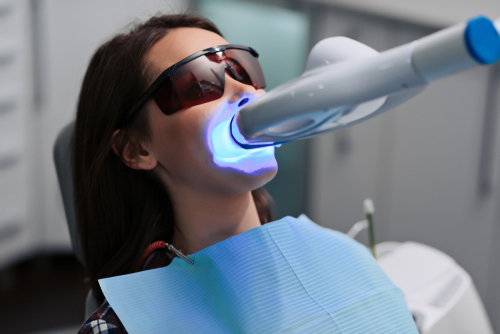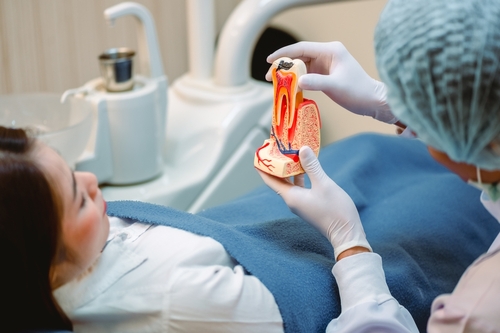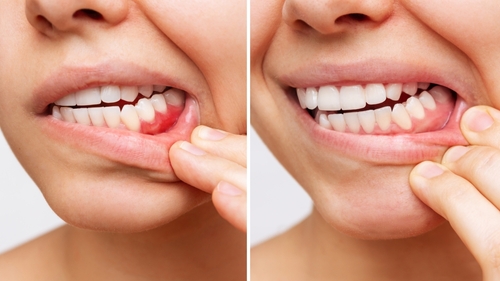
by sld | Dec 26, 2023 | Teeth Whitening
Teeth whitening is popular among many individuals who wish for a brighter smile. However, not everyone can afford the sometimes high cost of this cosmetic procedure out-of-pocket. If you’re a resident of Illinois and are covered by Medicaid, you might be wondering: Does Medicaid cover teeth whitening?
Dental Coverage Under Medicaid in Illinois
Medicaid is a state and federally-funded program that provides health insurance to eligible individuals and families. It is managed at the state level, which means that each state has some flexibility in determining what services are covered under their Medicaid program. Illinois has one of the best Medicaid coverage programs in the country. Illinois Medicaid coverage typically includes essential dental services, such as:
Preventive care
This may encompass routine check-ups, cleanings, and X-rays. Preventive care reduces your risk of developing serious dental problems like tooth decay and gum disease.
Restorative services
These include procedures like fillings, root canals, and extractions.
Emergency care
Medicaid can cover treatment for dental emergencies.
Oral surgery
Certain oral surgeries may be covered, particularly when medically necessary.
Cosmetic Dentistry and Medicaid
While Medicaid in Illinois prioritizes essential dental services to maintain and restore oral health, it does not generally cover cosmetic dentistry procedures like teeth whitening. Medicaid programs across different states typically adhere to this same principle, prioritizing necessary and medically required dental services over cosmetic treatments. As such, if you’re seeking teeth whitening or other cosmetic procedures, you may find that Medicaid will not cover the cost.
Alternative Options
If you are interested in teeth whitening but are not covered by Medicaid for this cosmetic procedure, don’t be discouraged. There are alternative options to explore.
Dental Insurance
Some dental insurance plans may offer coverage for cosmetic procedures, including teeth whitening, though it’s less common than other types of coverage. Check with your dental insurance provider to understand the specific provisions of your plan.
Flexible Spending Account (FSA) or Health Savings Account (HSA)
If you have an FSA or HSA, you can use pre-tax dollars to pay for teeth whitening, potentially reducing your out-of-pocket expenses.
Dental Savings Plans
Dental savings plans are discount plans that provide reduced rates on various dental treatments, including teeth whitening. This kind of plan can help make cosmetic dentistry more affordable where dental insurance falls short.
Consult Your Dentist
If you are considering teeth whitening and have concerns about the cost, it’s a good idea to consult with your dentist. They can provide you with information on the various teeth whitening options available, including the most appropriate treatments for your needs and budget.
At Smile League Dental, we are proud to provide the best teeth-whitening services in Joliet. Our knowledgeable and experienced team is happy to give you guidance and recommendations to help you achieve whiter teeth within your budget and in the most effective and safe manner. We can help you figure out what procedures are included in your Medicaid coverage or assist you in navigating your dental insurance plan. Give us a call today at 815-782-6243.

by sld | Nov 29, 2023 | Dental Service
Dental insurance coverage is a big factor when considering orthodontic treatment options. With the rising popularity of aligner treatments, the question of insurance coverage has become more relevant than ever. Are aligners covered by dental insurance in Illinois? What are your financial options for a straighter, healthier smile? Let’s explore some answers to these questions.
What Are Aligners?
An aligner, often referred to as a clear aligner, is a dental appliance that can sometimes serve as a less visible alternative to braces. It is a clear, plastic mold of your teeth that can be worn to gently straighten them. Aligners serve as a discreet, comfortable, and effective option for many patients seeking orthodontic treatment.
Understanding Dental Insurance Coverage
Dental insurance coverage can vary widely from one plan to another. Review your specific policy to determine the extent of your orthodontic coverage. In Illinois, as in many other states, dental insurance typically falls into two categories: traditional dental insurance and orthodontic insurance.
Traditional Dental Insurance
Traditional dental insurance usually covers preventive and diagnostic services, such as routine check-ups, cleanings, and X-rays, as well as restorative procedures like fillings and extractions. These plans may also cover a portion of orthodontic treatment costs in some cases, but this is not guaranteed.
Orthodontic Insurance
Orthodontic insurance is a separate type of coverage designed explicitly for orthodontic treatment, including braces and clear aligners. These policies provide more comprehensive coverage for orthodontic services.
Coverage for Aligners in Illinois
Illinois dental insurance providers often have specific coverage limitations for orthodontic treatments. Here are some key factors to consider:
Age Limit
Many dental insurance plans limit orthodontic coverage to individuals under a certain age. Typically, coverage is more readily available for children and teenagers.
Orthodontic Waiting Period
Some policies have waiting periods before they provide orthodontic coverage. You may need to wait for a specific period after purchasing the plan before becoming eligible for orthodontic benefits.
Pre-Authorization
In some cases, insurance providers may require pre-authorization before starting orthodontic treatment, meaning you’ll need to obtain approval from your insurance company before proceeding with aligner therapy.
Alternative Funding Options
If your dental insurance doesn’t provide sufficient coverage for clear aligners, don’t worry. There are other financing options that you may be able to explore:
Flexible Spending Account (FSA) or Health Savings Account (HSA)
These accounts allow you to use pre-tax dollars to pay for orthodontic treatment, potentially reducing your out-of-pocket costs.
Monthly Payment Plans
Many dental and orthodontic providers offer flexible payment plans that can help you spread the cost of treatment over several months, making it more manageable for your budget.
Orthodontic Discount Plans
Some organizations offer discount plans that can provide substantial savings on orthodontic treatments, including clear aligners.
CareCredit
This is a healthcare financing credit card that allows you to cover expenses related to dental and orthodontic treatment, with convenient monthly payments.
Contact Smile League Dental in Joliet
At Smile League Dental, one of our primary missions is to make dental care more affordable. If you have questions about getting aligners in Joliet, please don’t hesitate to give us a call. Our knowledgeable staff is happy to help you achieve a healthy and beautiful smile without breaking your budget. You can reach us at 815-782-6243.

by sld | Oct 18, 2023 | Dental Service
The words “root canal” strike fear in the hearts of many people. However, understanding what a root canal involves and its importance can ease those fears and potentially save your tooth. So, what exactly is a root canal and when is it helpful to have one?
A Tooth-Saving Procedure
A root canal is a dental procedure designed to treat an infected or severely damaged tooth. It involves removing the infected or damaged pulp (the inner part of the tooth) and cleaning, disinfecting, and sealing the tooth to prevent further infection. Contrary to popular belief, root canals are not painful but are performed to relieve pain and save your tooth.
How a Root Canal Help
Infection Control
When bacteria invade the pulp of a tooth, it can lead to infection. Left untreated, this infection can spread to the surrounding tissues and even enter your bloodstream, posing a risk to your overall health.
Pain Relief
An infected tooth can cause excruciating pain. A root canal provides relief by removing the infected pulp, eliminating the source of the pain.
Tooth Preservation
The main goal of a root canal is to save your natural tooth. Preserving your natural tooth is essential for maintaining proper chewing function, speech, and preventing surrounding teeth from shifting.
A Natural Smile
Replacing a missing tooth can be costly and time consuming. It often requires dental implants, bridges, or dentures. A root canal allows you to keep your natural tooth.
Common Myths About Root Canals
Are Root Canals Painful?
Thanks to modern techniques and anesthesia, root canals are no more painful than getting a dental filling. In fact, they are performed to relieve pain caused by infection.
Is Tooth Extraction a Better Option?
Removing a tooth should be the last resort. Saving your natural tooth through a root canal is generally more favorable, as it maintains the integrity of your dental arch and prevents the need for costly replacements.
Can I Just Take Antibiotics to Cure My Tooth Infection?
Antibiotics might help control the spread of an infection and temporarily relieve symptoms, but they cannot effectively address the issue alone. A root canal removes the source of the infection and is the best way to prevent the infection from persisting and worsening over time.
The Root Canal Procedure
The root canal procedure involves several steps.
Your dentist will assess your tooth’s condition through X-rays and clinical examination to determine if a root canal is necessary.
On the day of the procedure, local anesthesia is administered to numb the tooth and surrounding area. This ensures you will feel no pain during the procedure.
- Cleaning and Disinfection
The dentist creates an access point to the pulp chamber, removes the infected or damaged pulp, and thoroughly cleans and disinfects the root canals.
After cleaning, the dentist seals the tooth with a rubbery material to prevent further infection.
In many cases, a tooth that has undergone a root canal will require a crown to strengthen and protect it. Your dentist will take impressions for a custom-fitted crown.
Contact Smile League Dental
If you are looking for the safest and most reliable root canal treatment in Joliet, look no further! Smile League Dental’s team of professionals is ready to address all of your oral health needs. Give us a call at 815-782-6243.

by sld | Sep 5, 2023 | Gum Disease
Periodontal disease, also known as gum disease, is a serious problem for many people around the world. This chronic inflammatory condition can lead to serious consequences such as tooth loss and potential systemic health problems if left untreated. What can be done to treat periodontal disease? Can it be reversed?
What Is Periodontal Disease?
When plaque builds up on the teeth, it can create a breeding ground for harmful bacteria. This bacteria releases toxins, triggering inflammation in the gums. Without intervention, this inflammation can cause the breakdown of gum tissue and supporting bone, leading to pockets forming between the teeth and gums—pockets that further promote bacterial growth and infection.
The Stages of Periodontal Disease
Periodontal disease advances through stages, from mild to severe. The initial stage, known as gingivitis, is characterized by red, swollen gums that might bleed during brushing or flossing. It’s important to be able to recognize the symptoms of gingivitis because, with timely action, it can often be reversed. Professional dental cleanings and improved oral hygiene at home are usually the best way to reverse this mild form of periodontal disease.
If, however, gingivitis is left untreated, it can progress to periodontitis—a more severe form of gum disease. This stage involves both inflammation and irreversible damage to the teeth’s supporting structures. Here, the prospect of full reversal becomes more complex, yet there remains potential for effective management.
Managing Periodontal Disease
While a complete reversal of advanced periodontal disease might not be guaranteed, its progression can be effectively managed using some tried-and-true strategies:
Professional Dental Care
Regular dental visits are vital. A good dentist can perform deep cleaning procedures like scaling and root planing to remove plaque and tartar below the gum line, reducing inflammation and promoting healing.
Good Oral Hygiene
A consistent oral care routine that includes brushing, flossing, and using antimicrobial mouthwash plays a significant role in managing gum disease. Ask your dentist if you’re unsure about proper techniques for your home dental care.
Lifestyle Changes
Adopting a healthier lifestyle can go a long way toward preventing or treating gum disease. Quitting smoking, maintaining a balanced diet, managing stress, and staying hydrated all positively impact oral health.
Medications
Dental professionals might prescribe medications or antimicrobial rinses to control bacterial growth and inflammation.
Surgical Interventions
In severe cases of periodontal disease, surgical options like gum grafts or bone grafting might restore damaged tissue and promote bone regeneration.
Early Intervention Is Key
When it comes to treating periodontal disease, prevention, and early intervention are paramount. Detecting and treating gum disease early significantly enhances the chances of successful management, as well as the possibility of reversing the disease. Regular dental check-ups enable your dentist to identify signs of gum disease and provide tailored guidance for effective control.
Contact Smile League Dental
Having a good dentist in your corner is critical to winning the battle against periodontal disease. At Smile League Dental, we are proud to offer our expertise and support to families throughout Joliet and the surrounding areas. Call us today to chat or book an appointment. You can reach us at 815-782-6243.





Recent Comments